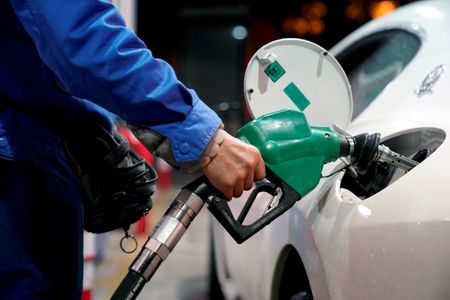By Muyu Xu
SINGAPORE (Reuters) – Road and air traffic in China, the world’s second-biggest oil consumer, has rebounded sharply after a significant easing in the country’s COVID-19 restrictions, boosting the outlook for fuel demand and supporting crude prices.
After almost three years of pursuing a policy targeting zero COVID cases, China last week abandoned many key curbs, including dropping frequent virus testing, relaxing quarantine rules and scrapping travel tracking.
The changes immediately triggered a significant rise in mobility, with road and air transport picking up for the first time in almost two months, according to data from the transport ministry, travel analytics firms and energy consultancies.
The global energy market is watching China’s recovering mobility closely. Demand in the world’s top oil buyer is expected to contract for the first time in two decades this year due to widespread lockdowns.
“Given the faster pace of reopening, we now expect mobility to normalise – reaching the June-July 2022 levels – by end-March 2023 versus our prior expectation of May/June,” Morgan Stanley analysts wrote in a note on Wednesday.
Bank of America Global Research analysts said they expected global oil benchmark Brent could quickly rise past $90 per barrel from current $80, partly on the back of a “successful” economic reopening by China.
Weekly domestic air passenger volumes jumped 68% last week from the prior week to 3.7 million – the biggest hike since the Lunar New Year holiday in February, according to aviation data provider Variflight. That number is still 37% lower than a year earlier and 68% lower than 2019, however.
The number of trucks travelling on highways also saw the first rebound last week since early October, according to data from the Ministry of Transportation.
Areas accounting for almost 20% of China’s total gross domestic product had been under some form of lockdown in November, according to brokerage Nomura, prompting rare protests against the stringent COVID measures.
Local authorities have now lifted lockdowns in areas with COVID cases and stopped frequent testing of truck drivers. No temporary shutdowns of highway tolls have been recorded since Dec. 8, transport ministry data showed.
An index compiled by Chinese fleet management company G7 showing the movement of fully laden trucks in China last week rose from a near-two month low in late November to close to the level of the same period in 2019.
Analysts sounded a note of caution, however, as an explosion in COVID cases could hamper the recent momentum in mobility.
“We believe such an improvement may stall or even reverse, as more travelling may lead to a wider spread of Omicron in the winter across the country,” said analysts from Nomura in a note on Tuesday, referring to the highly transmissible strain of COVID-19.
Chinese leaders have reportedly delayed a key economic policy meeting amid growing signs that COVID infections are surging in Beijing. The country reported more than 7,000 COVID cases on both Sunday and Monday, but the actual infections could be far higher as COVID tests are no longer mandatory.
The road congestion index for Beijing over the past seven days is well below the same period last year, possibly indicating that residents are less willing to travel due to the sharp rise in COVID cases.
It is unclear how many people will travel during the Lunar New Year holiday next month, normally a period of peak travel when city residents return to their home regions to celebrate with family.
Fuel traders appear optimistic, however.
China’s commercial gasoline inventories fell last week for the first time since the seven-day National Day vacation period in early October, data compiled by consultancy Longzhong showed, as traders increased purchases in anticipation of stronger gasoline demand.
(This story has been refiled to remove extraneous word ‘from’ in paragraph 5)
(Reporting by Muyu Xu; Additional reporting by Beijing Newsroom and Trixie Yap in Singapore; Editing by Dominique Patton and Kenneth Maxwell)

